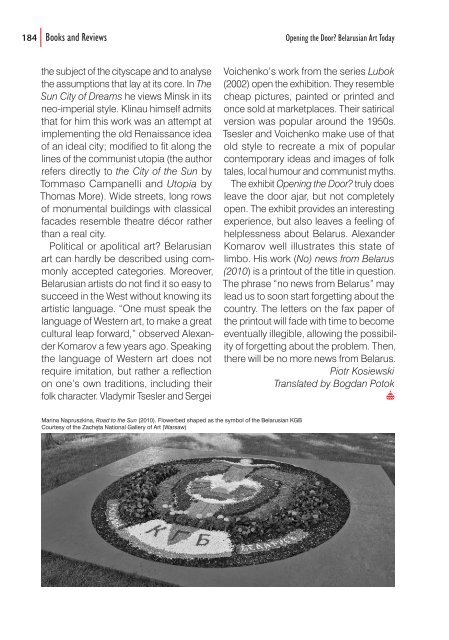Create successful ePaper yourself
Turn your PDF publications into a flip-book with our unique Google optimized e-Paper software.
184 Books and Reviews Opening the Door? Belarusian Art Today<br />
the subject of the cityscape and to analyse<br />
the assumptions that lay at its core. In The<br />
Sun City of Dreams he views Minsk in its<br />
neo-imperial style. Klinau himself admits<br />
that for him this work was an attempt at<br />
implementing the old Renaissance idea<br />
of an ideal city; modifi ed to fi t along the<br />
lines of the communist utopia (the author<br />
refers directly to the City of the Sun by<br />
Tommaso Campanelli and Utopia by<br />
Thomas More). Wide streets, long rows<br />
of monumental buildings with classical<br />
facades resemble theatre décor rather<br />
than a real city.<br />
Political or apolitical art? Belarusian<br />
art can hardly be described using commonly<br />
accepted categories. Moreover,<br />
Belarusian artists do not fi nd it so easy to<br />
succeed in the West without knowing its<br />
artistic language. “One must speak the<br />
language of Western art, to make a great<br />
cultural leap forward,” observed Alexander<br />
Komarov a few years ago. Speaking<br />
the language of Western art does not<br />
require imitation, but rather a refl ection<br />
on one’s own traditions, including their<br />
folk character. Vladymir Tsesler and Sergei<br />
Marina Napruszkina, Road to the Sun (2010). Flowerbed shaped as the symbol of the Belarusian KGB<br />
Courtesy of the Zachęta National Gallery of Art (Warsaw)<br />
Voichenko’s work from the series Lubok<br />
(2002) open the exhibition. They resemble<br />
cheap pictures, painted or printed and<br />
once sold at marketplaces. Their satirical<br />
version was popular around the 1950s.<br />
Tsesler and Voichenko make use of that<br />
old style to recreate a mix of popular<br />
contemporary ideas and images of folk<br />
tales, local humour and communist myths.<br />
The exhibit Opening the Door? truly does<br />
leave the door ajar, but not completely<br />
open. The exhibit provides an interesting<br />
experience, but also leaves a feeling of<br />
helplessness about Belarus. Alexander<br />
Komarov well illustrates this state of<br />
limbo. His work (No) news from Belarus<br />
(2010) is a printout of the title in question.<br />
The phrase “no news from Belarus” may<br />
l ead us to soon start forgetting about the<br />
country. The letters on the fax paper of<br />
the printout will fade with time to become<br />
eventually illegible, allowing the possibility<br />
of forgetting about the problem. Then,<br />
there will be no more news from Belarus.<br />
Piotr Kosiewski<br />
Translated by Bogdan Potok



